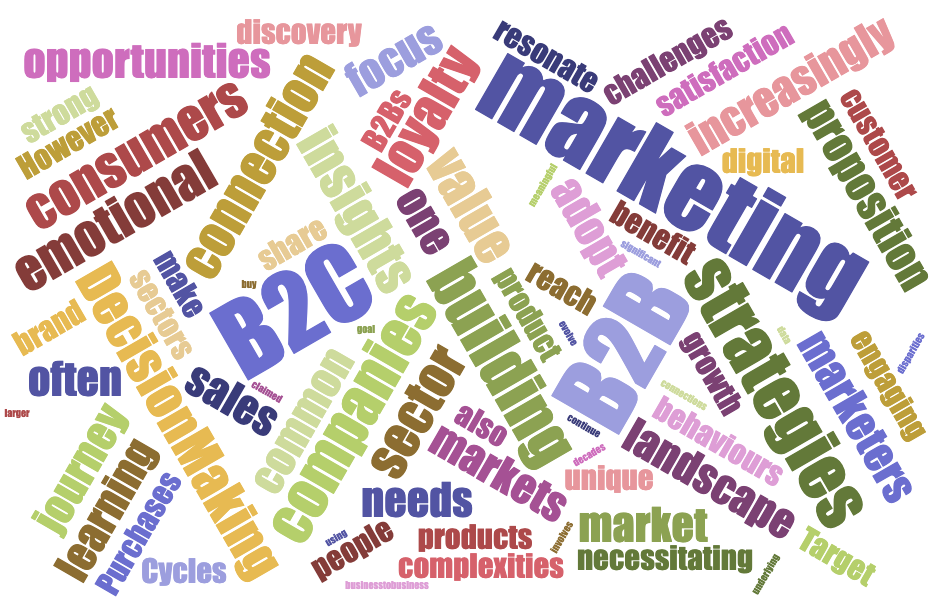As has been claimed for decades, there are differences between B2C marketing strategies and those of business-to-business (B2B).
However, as companies continue to evolve in an increasingly digital landscape, these disparities, while significant, share the underlying goal of establishing meaningful connections with the people who buy their products and services.
As companies strive to navigate the complexities of their respective markets, the learnings one can gain from examining the nuances of both B2B and B2C marketing become self-evident.
This is why I decided this week to examine not only the unique challenges and opportunities inherent to each industry, but also to reveal the transformative insights one sector can adopt from the other.
Understanding the Landscape of B2B vs. B2C Marketing
At the heart of all effective marketing strategies lies the principle of satisfaction and connection. It involves understanding the needs, desires, and behaviours of your customers/consumers/clients (C³ – now you know where our company name comes from!) and then composing messages that resonate with them. However, the path to achieving this relationship differs significantly between B2B and B2C marketing.
B2B Marketing: The Complex Web of Decision-Making
B2B marketing focuses on addressing the needs, interests, and challenges of the decision-makers who make the purchases on behalf of their organizations. This realm is characterized by:
- Longer Sales Cycles: B2B transactions often involve substantial investments, necessitating a more extended period of deliberation, approval, and procurement processes.
A study by Gartner highlighted that 77% of B2B buyers stated their latest purchase was very complex or difficult. B2B transactions, such as IBM’s enterprise software solutions or Caterpillar’s heavy machinery, involve substantial investments and can extend for months or even years. This complexity necessitates marketers to engage in continuous nurturing strategies, educational content provision, and stakeholder management to guide the decision-making process.
- Rational Decision-Making: Decisions are driven by logic, return on investment (ROI), and efficiency gains, requiring marketers to focus on the value proposition and detailed product information.
B2B decisions are driven by logic and ROI. For instance, Salesforce markets its CRM solutions by highlighting efficiency gains, scalability, and improved sales metrics, appealing directly to organizational goals and the bottom line.
- Relationship Building: Given the smaller target market and higher stakes involved, forging strong, long-term relationships with clients is paramount.
The emphasis on cultivating long-term relationships is exemplified by the account-based marketing (ABM) approach, where companies like Adobe focus on individual client accounts as markets in their own right, customizing their marketing efforts to each account’s specific needs and history with the brand.
B2C Marketing: The Emotional Journey
In contrast, B2C marketing targets directly individual consumers, tailoring strategies to meet their personal preferences and behaviours. This sector is typified by:
- Shorter Sales Cycles: Purchases are often impulsive or based on immediate needs, leading to quicker decision-making processes.
B2C purchases, ranging from impulse buys like a new pair of Nike sneakers to more considered purchases like a Peloton bike, often involve shorter decision times. Nike excels in creating an emotional appeal through inspirational storytelling, directly influencing consumer impulse and desire.
- Emotional Decision-Making: B2C marketing leverages storytelling, branding, and emotional appeals to foster a personal connection with the consumer.
Apple’s marketing strategy capitalizes on emotional branding, creating a sense of belonging and identity among users. By leveraging emotional appeals, Apple not only sells products but also an experience and a lifestyle.
- Broad Target Market: The consumer base is typically larger and more varied, necessitating a wider reach and more general messaging.
Coca-Cola’s global marketing campaigns are a prime example of addressing a broad target market. Its “Share a Coke” campaign, which personalized bottles with names and phrases, showcased the power of personalization at scale, engaging consumers across different demographics and regions.
Bridging the Gap: Finding Common Grounds
Despite these differences, both B2B and B2C marketing share common goals: engaging their audience, building brand loyalty, and driving sales.
Both sectors are increasingly leveraging digital technologies to reach their audiences, using data analytics to refine their strategies and embracing social media and other platforms as vital channels for engagement and insight development.
Digital technologies have been a game-changer in both B2B and B2C sectors. According to a Salesforce report, 84% of customers say the experience a company provides is as important as its products and services. This is true for both B2B and B2C markets, where digital platforms, social media, and data analytics play pivotal roles in understanding and engaging with audiences.
For instance, both B2B and B2C marketers are leveraging platforms like LinkedIn for targeted content marketing and networking, while using Instagram and Facebook for broader brand awareness and engagement. Adobe’s Creative Cloud subscriptions cater to both individual creatives and large enterprises, utilizing tailored messaging across platforms to appeal to each segment’s unique needs and decision-making processes.
Cross-Sector Learning: Insights and Actions
The distinction between B2B and B2C marketing offers a unique opportunity for cross-pollination of strategies. Here are some actionable insights each sector can learn from the other:
From B2C to B2B: Embracing the Power of Branding and Emotion
- Leverage Storytelling: B2B marketers can adopt B2C’s emphasis on emotional connection by crafting compelling narratives around their products and services, highlighting the human element of their offerings.
GE’s use of Instagram to showcase industrial projects through compelling visuals and narratives demonstrates how B2B companies can humanize their brand and connect emotionally with a broader audience.
- Invest in Branding: Building a strong brand identity is not exclusive to consumer markets. B2B companies can benefit from establishing recognizable and trusted brands to differentiate themselves in crowded markets.
- Personalization: Data-driven personalization, a cornerstone of B2C marketing, can significantly improve the B2B customer experience, enhancing loyalty and satisfaction.
Amazon Business serves as a powerful example of how B2B experiences are increasingly mirroring B2C standards of personalization, offering customized recommendations and tailored buying experiences for business customers.
From B2B to B2C: Prioritizing Value and Relationships
- Focus on Value Proposition: B2C marketers can borrow B2B’s focus on articulating the value proposition, ensuring consumers understand not just the product but its benefit, relevance and utility to their lives.
- Cultivate Loyalty Through Engagement: B2C companies can adopt B2B’s emphasis on relationship building, engaging consumers through loyalty programs, community building, and personalized customer service.
- Educational Content: Providing informative content, a common B2B tactic, can also enrich B2C marketing by helping consumers make informed decisions, thereby building trust and credibility.
MyFitnessPal, a B2C app, offers personalized diet and exercise tracking but stands out by providing extensive educational content. This approach mirrors B2B strategies, helping users make informed decisions about their health and wellness, thereby fostering trust and loyalty.
Conclusion: A Convergence of Strategies
In today’s dynamic world of marketing, the lines between B2B and B2C are increasingly blurred. Recognizing the strengths and learning opportunities presented by each approach allows for the integration of successful strategies from one sector to the other.
For example, Adobe’s transition from selling boxed software to a subscription-based model reflects a blend of B2B and B2C marketing philosophies, focusing on long-term customer relationships, value provision, and personalization at scale.
In the future, the distinction between B2B and B2C marketing will continue to blur, with each sector adopting and adapting strategies from the other. Companies that recognize and implement these cross-sector learnings will not only navigate the complexities of their markets more effectively but also forge deeper, more meaningful connections with their audiences.
In harnessing the insights and methodologies from both sectors, organizations can achieve a more holistic and impactful marketing strategy, tailored to the complexities and demands of the modern marketplace.
After all, people often compare their experiences both good and bad across sectors, with little regard for the category. Shouldn’t we do the same?











